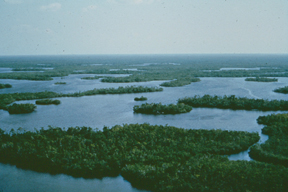Geotimes

Web
Extra Friday,
January 31
Everglades science management
under scrutiny
As the world's largest ecosystem restoration effort struggles forward in South
Florida's Everglades, the Department of the Interior (DOI) will need to make
both financial and management improvements to ensure that science can effectively
guide the restoration, according to a recent report from the National Research
Council (NRC).
In 1997, DOI established CESI, the Critical Ecosystem Studies Initiative, to
provide science for restoring ecosystems on DOI lands in South Florida, particularly
in Everglades National Park. CESI focuses on addressing urgent science information
gaps and emerging research needs.
 This month,
an NRC panel of scientists released an assessment of CESI, determining that,
while CESI has made valuable contributions to the restoration effort, recent
budget cuts will hamper the ability of the program to continue to fulfill its
objectives. However, the panel also determined that improvements could begin
with changes in how CESI is managed.
This month,
an NRC panel of scientists released an assessment of CESI, determining that,
while CESI has made valuable contributions to the restoration effort, recent
budget cuts will hamper the ability of the program to continue to fulfill its
objectives. However, the panel also determined that improvements could begin
with changes in how CESI is managed.
The
Ten Thousand Islands in Everglades National Park are a maze
of mangrove islands and shallow creeks along the Gulf Coast of Florida.
Photo supplied by Everglades National
Park.
"Congress should increase CESI research funding to meet DOI's restoration
science needs, contingent upon several high-priority improvements in CESI management,"
the report stated.
From the late 19th through most of the 20th century, developers used an extensive
system of dikes, canals and levees to make the periodically saturated "river
of grass" into dry land available for agriculture and human habitation.
A rising tide of protests from naturalists led to the dedication of Everglades
National Park in 1947. But decades of drainage, agricultural nutrient runoff
and increased pressure on water supply sources following rapid urban expansion
have complicated water quality issues across southern Florida.
In 1992, Congress authorized what has been called a "Restudy" of the
Central and South Florida water-management system to determine whether it could
be modified to improve South Florida's sustainability.
The result of the Restudy was the Comprehensive Everglades Restoration Plan
(CERP), which Congress approved in 2000. CERP's objective was to design a water
management system for the Everglades that would restore and protect the ecosystem
while still controlling floods and supplying water to the region. CESI, in turn,
was created to provide scientific support for these objectives — both for
the present, by funding scientific research on how ecosystems work and on how
the natural system had been altered by development; and for the future, by developing
hydrological and ecological models to predict long-term effects of restoration.
However, the budget for CESI has dwindled from a high of $12 million in 1998
to only $4 million in 2002. Such budget cuts, the NRC report notes, have necessitated
difficult choices and made targeting every high-priority science need impossible.
Inadequate funding for science is potentially costly if inadequately researched
restoration projects should need to be redesigned, the report says. "It's
not a cost-effective way to do a restoration," says Linda Blum of the University
of Virginia at Charlottesville and chair of the panel.
The NRC report notes that "funding for CESI science has been inconsistent
and is now far less than is needed to support DOI's interests in and responsibilities
for the restoration." At the same time, it found that the CESI program
could be made more effective by reorganizing its management structure, by placing
higher emphasis on currently unmet science information needs, and by more broadly
disseminating information to other restoration agencies and to the public.
"It was our contention that while we felt that CESI was under-funded,
what we would like to see is them develop programs in the areas that there are
gaps, decide how much money it would take to address those problems, and then
go to DOI and Congress and ask for that money; but that any new money coming
into the CESI program would need to be dependent upon improving the management,"
Blum says.
 Several
areas in which the report finds that CESI management requires immediate attention
include "the narrow distribution of requests for proposals, an insufficient
peer-review process, and limited involvement of expert advisors." Although
the report was not intended to review CESI-funded science, it does highlight
some critical restoration science needs that have not yet been met in the areas
of social science, water-quality modeling and contaminants.
Several
areas in which the report finds that CESI management requires immediate attention
include "the narrow distribution of requests for proposals, an insufficient
peer-review process, and limited involvement of expert advisors." Although
the report was not intended to review CESI-funded science, it does highlight
some critical restoration science needs that have not yet been met in the areas
of social science, water-quality modeling and contaminants.
Urban encroachment on the Everglades
in Dade County, Florida. Photo from South Florida Water Management District.
CESI and other restoration projects need to better synthesize their results,
the NRC panel found. "There's very good science going on in support of
DOI needs," Blum says. "But among those individual projects the coordination
and synthesis aren't as strong as they could be or should be."
The concerns the NRC report targets are not unique to any single restoration
agency, says Robert Johnson, director of the South Florida Natural Resources
Center at Everglades National Park.
"There are still issues about the need to integrate better the science
programs across the three DOI bureaus in south Florida, and this review was
specific to the CESI, which is in the NPS program," he says. "There
are similar funding initiatives like this for both the Fish and Wildlife Service
and the USGS, and I think the comments on the need for external peer review
and the comments on the need for integrating science and research into very
clear management positions is universal."
Carolyn Gramling
Geotimes contributing writer
Links:
Critical
Ecosystem Studies Initiative Assessment Report
 This month,
an NRC panel of scientists released an assessment of CESI, determining that,
while CESI has made valuable contributions to the restoration effort, recent
budget cuts will hamper the ability of the program to continue to fulfill its
objectives. However, the panel also determined that improvements could begin
with changes in how CESI is managed.
This month,
an NRC panel of scientists released an assessment of CESI, determining that,
while CESI has made valuable contributions to the restoration effort, recent
budget cuts will hamper the ability of the program to continue to fulfill its
objectives. However, the panel also determined that improvements could begin
with changes in how CESI is managed. 
 Several
areas in which the report finds that CESI management requires immediate attention
include "the narrow distribution of requests for proposals, an insufficient
peer-review process, and limited involvement of expert advisors." Although
the report was not intended to review CESI-funded science, it does highlight
some critical restoration science needs that have not yet been met in the areas
of social science, water-quality modeling and contaminants.
Several
areas in which the report finds that CESI management requires immediate attention
include "the narrow distribution of requests for proposals, an insufficient
peer-review process, and limited involvement of expert advisors." Although
the report was not intended to review CESI-funded science, it does highlight
some critical restoration science needs that have not yet been met in the areas
of social science, water-quality modeling and contaminants. 